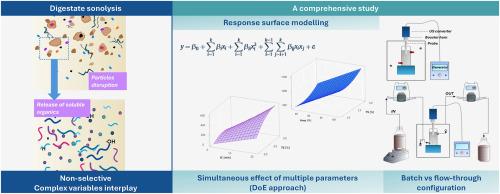消化污泥的超声处理:工艺参数的相互作用和批处理和流动配置的比较评估。
IF 7.7
2区 环境科学与生态学
Q1 ENVIRONMENTAL SCIENCES
引用次数: 0
摘要
超声(US)处理代表了一个有前途的策略,以提高能量回收和废物最小化在厌氧消化(AD)系统。然而,重大的知识差距阻碍了美国在全面过程中的有效应用。特别是,厌氧消化污泥(ADS)的处理在文献中受到的关注有限,尽管它有可能增强顽固有机组分的分解并改善AD过程的整体能量平衡。此外,现有的研究通常是单独考察US参数的影响,往往忽略了变量之间的相互作用。在本研究中,通过多变量实验方法研究了美国对ADS的治疗。采用响应面法,特别是Box-Behnken设计,评估了三个关键变量(即总固体含量、US振幅和处理时间)对指示有机质分解和溶解的四个响应因子(即分解程度、可溶性蛋白质、可溶性碳水化合物和挥发性脂肪酸)的影响。值得注意的是,我们首次研究了变量的同时效应,表明所选变量之间存在显著的相互作用。基于回归的模型拟合获得了高度的统计显著性。此外,在相同的操作条件下,该研究比较了静态和流动配置下的美国处理,揭示了混合制度对整个过程性能的关键影响。所提出的研究结果为美国污泥处理应用反应器的设计和优化提供了有价值的见解,提供了与环境相关的策略,以改善废水管理系统中消化液的价值。本文章由计算机程序翻译,如有差异,请以英文原文为准。

Ultrasound treatment of digested sludge: process parameters interaction and comparative assessment of batch and flow-through configurations
Ultrasound (US) treatment represents a promising strategy to enhance energy recovery and waste minimization in anaerobic digestion (AD) systems. However, significant knowledge gaps hinder the effective application of US into full-scale processes. Particularly, the treatment of anaerobically digested sludge (ADS) has received limited attention in the literature, despite its potential to enhance the disintegration of recalcitrant organic fractions and improve the overall energy balance of the AD process. Furthermore, existing research typically investigates the effect of US parameters individually, often neglecting interactions between variables. In this study, the US treatment of ADS was investigated through a multivariable experimental approach. A response surface methodology, specifically a Box–Behnken design, was employed to assess the effects of three key variables, namely the total solids content, the US amplitude, and the treatment duration, on four response factors indicative of organic matter disintegration and solubilization, i.e. disintegration degree, soluble proteins, soluble carbohydrates and volatile fatty acids. Notably, the simultaneous effect of the variables was investigated for the first time, demonstrating significant interactions among the selected variables. A high degree of statistical significance was obtained from the regression-based model fitting. In addition, the study compared US treatment in both static and flow-through configurations, under identical operating conditions, revealing the critical influence of the mixing regime on the overall process performance. The presented findings provide valuable insights for the design and optimisation of US reactors for sludge treatment applications, offering environmentally relevant strategies to improve the valorisation of digestate in wastewater management systems.
求助全文
通过发布文献求助,成功后即可免费获取论文全文。
去求助
来源期刊

Environmental Research
环境科学-公共卫生、环境卫生与职业卫生
CiteScore
12.60
自引率
8.40%
发文量
2480
审稿时长
4.7 months
期刊介绍:
The Environmental Research journal presents a broad range of interdisciplinary research, focused on addressing worldwide environmental concerns and featuring innovative findings. Our publication strives to explore relevant anthropogenic issues across various environmental sectors, showcasing practical applications in real-life settings.
 求助内容:
求助内容: 应助结果提醒方式:
应助结果提醒方式:


